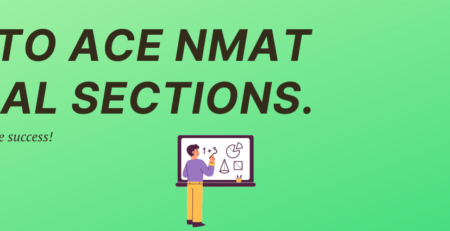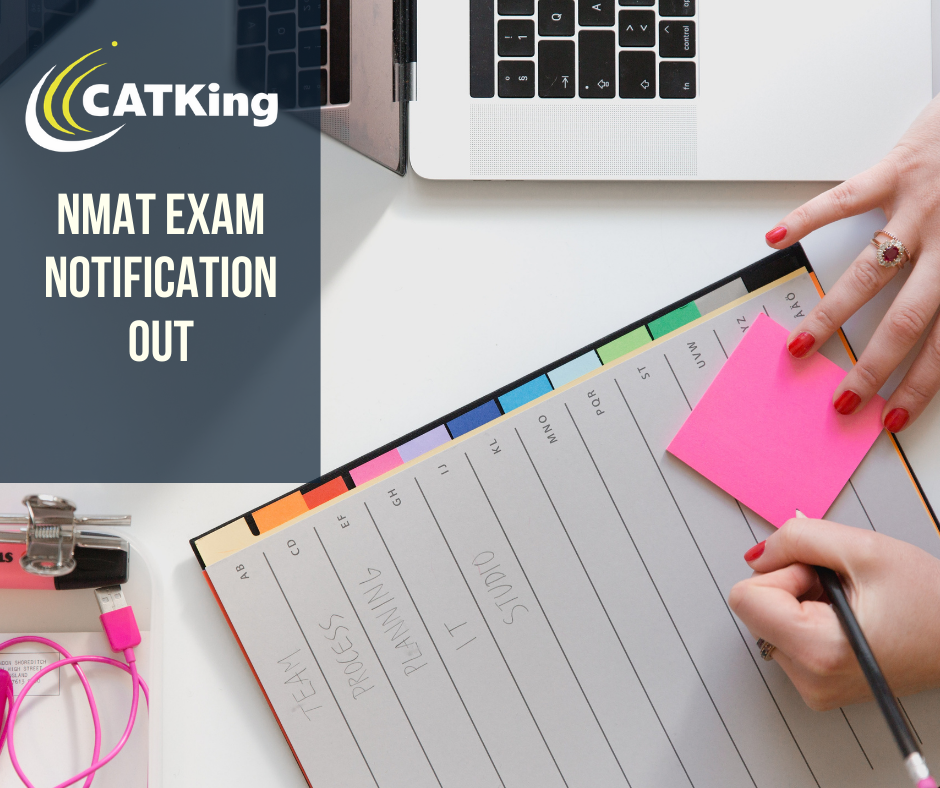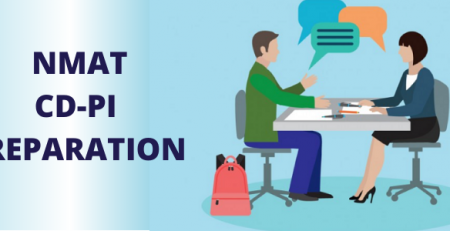NMAT 2021: How to prepare for NMAT verbal- Valuable Tips
NMAT is an exam conducted by GMAC to get admissions into Narsee Monjee Institute of Management Studies (NMIMS) and some other top-ranked private colleges. NMAT exam is known to be one of the most prestigious exams for management courses in India. The NMAT exam is held every year from October to December and this year as well it will be conducted from 6th October 2020 to 19th December 2020. In this article, we give you tips and tricks for NMAT Verbal section.
Exam pattern of NMAT 2021 (New)
|
Section |
Number of Questions |
Allotted Time |
|
Language Skills |
36 |
28 minutes |
|
Quantitative Skills |
36 |
52 minutes |
|
Logical Reasoning |
36 |
42 minutes |
|
Total |
108 questions |
120 minutes |
Syllabus for NMAT verbal
-
Use of Idioms
-
Corrections of grammatical errors
-
Fill in the blanks
-
Usage of Parts of speech, Tenses, Conditional
-
Reading Comprehension Passages
-
Jumbled Sentences
-
Syntax
- Vocabulary Usages
-
Phrasal Verbs
-
Sentence Correction and usage
Tips for Reading Comprehension in NMAT Verbal
1. Do not expect to be completely familiar with any of the material presented in reading comprehension passages. You may find some passages easier to understand than others, but all passages are designed to present a challenge. If you have some familiarity with the material presented in a passage, do not let this knowledge influence your choice of answers to the questions. Answer all questions on the basis of what is stated or implied in the passage itself.
2. Analyze each passage carefully, because the questions require you to have a specific and detailed understanding of the material. You may find it easier to do the analysis first before moving to the questions. You may find that you prefer to skim the passage the first time and read more carefully once you understand what a question asks. You may even want to read the question before reading the passage. You should choose the method most suitable for you.
3. Focus on keywords and phrases, and make every effort to avoid losing the sense of what is discussed in the passage. Keep the following in mind: Note where the passage moves from one idea to the next. Separate main ideas from supporting ideas. Determine what conclusions are reached and why. Note how each fact relates to an idea or an argument.
4. Read the questions carefully, making certain that you understand what is asked. An answer choice that accurately restates information in the passage may be incorrect if it does not answer the question. If you need to, refer back to the passage for clarification.
5. Read all the choices carefully. Never assume that you have selected the best answer without first reading all the choices.
6. Select the choice that answers the question best in terms of the information given in the passage.
Do not rely on outside knowledge of the material to help you answer the questions.
7. Remember that comprehension一not speed一is the critical success factor when it comes to reading
comprehension questions.
Tips for Critical Reasoning in NMAT Verbal:
- Read very carefully the set of statements on which a question is based. Pay close attention to
• what is put forward as factual information
• what is not said but necessarily follows from what is said
• what is claimed to follow from facts that have been put forward
• how well substantiated are any claims that a particular conclusion follows from the facts that have been put forward in reading the arguments, it is important to pay attention to the logical reasoning used; the actual truth of statements portrayed as fact is not important. - Identify the conclusion. The conclusion does not necessarily come at the end of the text; it may come somewhere in the
middle or even at the beginning. Be alert to clues in the text that an argument follows logically from another statement or statements in the text. - Determine exactly what each question asks. You might find it helpful to read the question first, before reading the material on which it is based; don’t assume that you know what you will be asked about an argument. An argument may have obvious flaws, and one question may ask you to detect them. Other questions may direct you to select the one answer choice that does NOT describe a flaw in the argument.
- Read all the answer choices carefully. Do not assume that a given answer is the best without first reading all the choices.
Tips or Para jumbles in NMAT Verbal:
1. Forming a mandatory pair: Mandatory pair is a set of statements that seem to come one after the other. Whenever you sense a mandatory pair, just look at the choices. If only one choice has a pair, that might be the answer. But obviously, if more than one choice has the same mandatory pair then we should adopt some other tactics as follow:
a.) Pronoun – antecedent method: The noun that precedes a pronoun is called antecedent to the pronoun. Let us take an example.
Sentence 1: Shahrukh Khan is the best actor in India.
Sentence 2: He has amply demonstrated his versatility through the years.
Now, ‘Shahrukh Khan’ is the antecedent to the pronoun ‘He’. You need to look for a male antecedent. If there is a ‘she’ then – female antecedent, they – plural antecedents and so on. The sentence with pronoun will come after the sentence containing the respective ‘noun’
b.) Linking words: Whenever two sentences come one after the other, there is usually a word that links them. If you can observe these links then you may be able to arrive at a mandatory pair easily.
c.) Chronological order: Many times it is easy to form a mandatory pair based on Chronological dates, words like “initially, then, later” etc. Most of the time these words appear at the start of the lines.
d.) Logical relationships like cause-effect: Many times mandatory pair can be identified by the logical flow of ideas/cause-effect relationship. (Use your own examples/creativity to explain this)
2. Identifying an obvious opener or Topic sentence or introductory sentence or Lead sentence: Here we are defining an obvious opener as one which can be a good starting point for the jumble. An obvious opener could be one which seems like a relatively independent statement that introduces something. It would normally not start with the following words.
a.) Carry forward words: Words like “and, so, moreover” which carry forward a line of thought expressed in the earlier statement.
b.) Contrast words: Words like “but, however, nevertheless” which create a Contradiction with the earlier line of thought.
c.) Conclusive words: Words like finally, thus, eventually, etc. which conclude. If a particular statement looks like a good starting point, then look at the choices to eliminate the wrong options.
3. Obvious conclusion: If a particular statement looks like one which has to come at the end then that is called an obvious conclusion. It usually happens when one of the conclusive words comes in the sentence.
4. Logical flow: Even though 1 and 2 can provide good clues, many students are able to look at the logical flow of ideas and crack the Para-jumble. 1 and 2 are tools that can supplement logic.
5. Make use of options: In case you cannot identify the Topic or Introductory sentence for whatever reason (maybe the text is difficult to comprehend or the Para-jumble is taken from the middle of the passage); look at the options. If you can see a pattern in the choices then you can sequence the statements based on the choices or see which of the choice sequence makes sense.
Tips for Sentence Correction in NMAT Verbal:
- Read the entire sentence carefully. Try to understand the specific idea or relationship that the sentence should express.
- Evaluate the underlined passage for errors and possible correction before reading the answer choices. This strategy will help you discriminate among the answer choices. Remember, in some cases the underlined passage is correct.
- Read each answer choice carefully The first answer choice always repeats the underlined portion of the original sentence. Choose this
answer if you think that the sentence is best as originally written, but do so only after examining all the other choices. - Try to determine how to correct what you consider to be wrong with the original sentence. Some of the answer choices may change things that are not wrong, whereas others may not change everything that is wrong.
- Make sure that you evaluate the sentence and the choices thoroughly. Pay attention to general clarity, grammatical and idiomatic usage, economy and precision of language, and appropriateness of diction.
- Read the whole sentence, substituting the choice that you prefer for the underlined passage. A choice may be wrong because it does not fit grammatically or structurally with the rest of the sentence. Remember that some sentences will require no correction. When the given sentence requires no correction, choose the first answer.
Related Links:
















Leave a Reply
You must be logged in to post a comment.